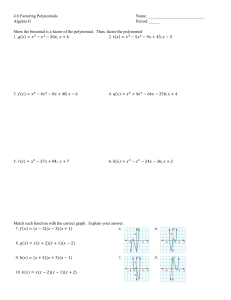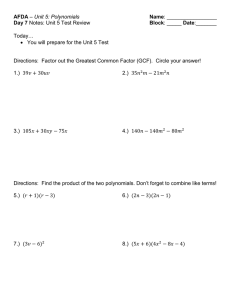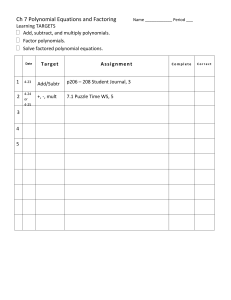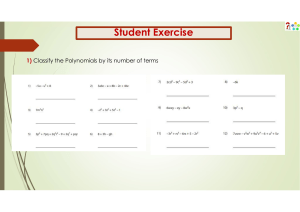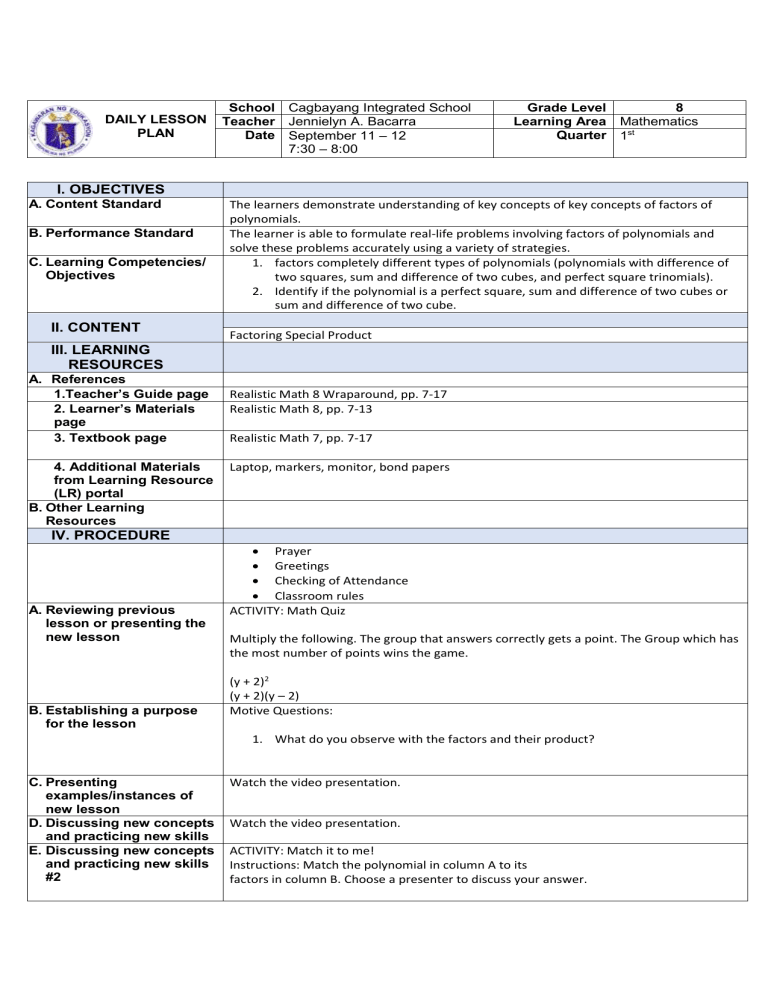
DAILY LESSON PLAN School Cagbayang Integrated School Teacher Jennielyn A. Bacarra Date September 11 – 12 7:30 – 8:00 Grade Level 8 Learning Area Mathematics Quarter 1st I. OBJECTIVES A. Content Standard B. Performance Standard C. Learning Competencies/ Objectives II. CONTENT The learners demonstrate understanding of key concepts of key concepts of factors of polynomials. The learner is able to formulate real-life problems involving factors of polynomials and solve these problems accurately using a variety of strategies. 1. factors completely different types of polynomials (polynomials with difference of two squares, sum and difference of two cubes, and perfect square trinomials). 2. Identify if the polynomial is a perfect square, sum and difference of two cubes or sum and difference of two cube. Factoring Special Product III. LEARNING RESOURCES A. References 1.Teacher’s Guide page 2. Learner’s Materials page 3. Textbook page 4. Additional Materials from Learning Resource (LR) portal B. Other Learning Resources Realistic Math 8 Wraparound, pp. 7-17 Realistic Math 8, pp. 7-13 Realistic Math 7, pp. 7-17 Laptop, markers, monitor, bond papers IV. PROCEDURE A. Reviewing previous lesson or presenting the new lesson B. Establishing a purpose for the lesson Prayer Greetings Checking of Attendance Classroom rules ACTIVITY: Math Quiz Multiply the following. The group that answers correctly gets a point. The Group which has the most number of points wins the game. (y + 2)2 (y + 2)(y – 2) Motive Questions: 1. What do you observe with the factors and their product? C. Presenting examples/instances of new lesson D. Discussing new concepts and practicing new skills E. Discussing new concepts and practicing new skills #2 Watch the video presentation. Watch the video presentation. ACTIVITY: Match it to me! Instructions: Match the polynomial in column A to its factors in column B. Choose a presenter to discuss your answer. 1. x2 + 6x + 9 2. x2 – 25 3. 8x3 + 1 4. 27x3 – 8 a. (2y + 1) (4y2 – 2y + 1) b. (x + 5) (x – 5) c. (x + 1) (x – 1) d. (3u – 1) (9u2 + 2y + 1) e. (x +3)2 F. Developing mastery (Leads to Formative Assessment) G. Finding practical application of the concept in daily living H. Making generalization about the lesson I. Evaluating learning J. Additional activities for application or remediation V. REMARKS VII. REFLECTION A. No. of learners who earned 80% in the evaluation. B. No. of learners who require additional activities for remediation C. Did the remedial lessons work? No. of learners who caught up with the lesson. D. No. of learners who continue to require remediation. 1. The height of a cube furniture piece is x + 10 inches. If the volume of cube is x3 + 1000 cubic inches, how much area does each face of the cube? 2. a small square is cut from the corner of a square piece of paper. If the side of the bigger square is twice as large as the side of the small square, what expression could represent the area of the remaining paper? Guide Questions for Generalization: What is a polynomial? How can we obtain the factors of polynomials using common monomial factor? What concepts have you learned from factoring that can be applied in your daily living? Factor the following completely. 1. a2 + 20a +100 2. f2 – 4 3. n3 + 8 4. u4 – v4 What value(s) of h is x2 – 5x + h a factor of x3 + 125? E. Which of my teaching strategies worked well? Why did these work? F. What difficulties did I encounter which my principal or supervisor can help me solve? G. What innovation or localized materials did I used/discover which I wish to share with other teacher?
